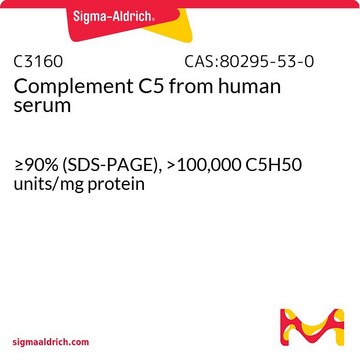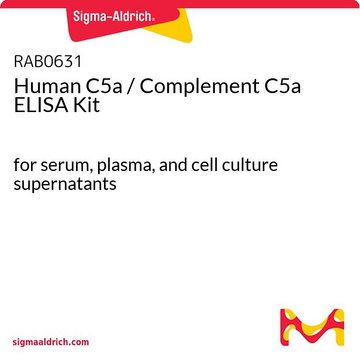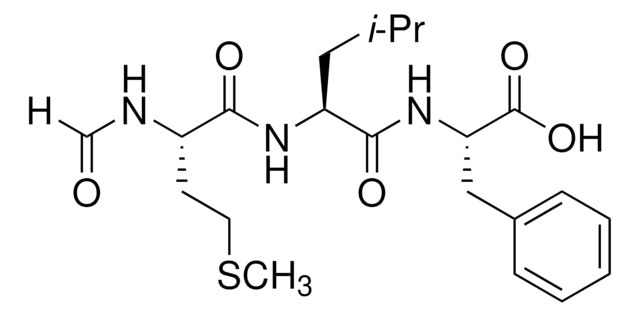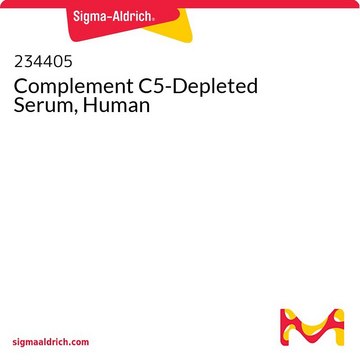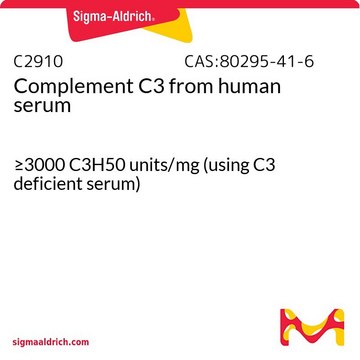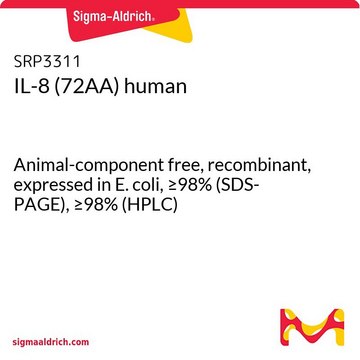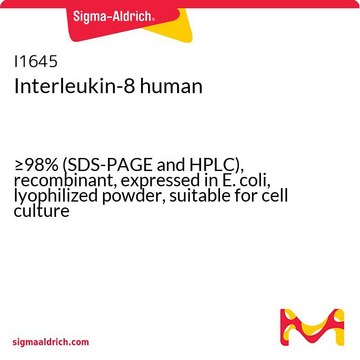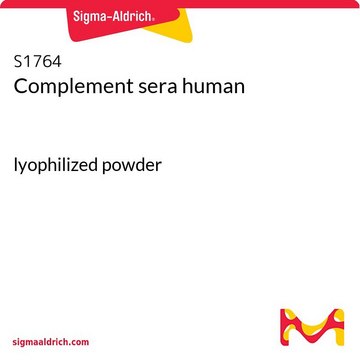C5788
Complement C5a human
recombinant, expressed in E. coli, ~95% (SDS-PAGE), lyophilized powder
Synonym(s):
C5a anaphylatoxin, rC5a
Sign Into View Organizational & Contract Pricing
All Photos(1)
About This Item
Recommended Products
biological source
human
Quality Level
recombinant
expressed in E. coli
Assay
~95% (SDS-PAGE)
form
lyophilized powder
technique(s)
activity assay: suitable
UniProt accession no.
shipped in
dry ice
storage temp.
−20°C
Gene Information
human ... C5(727)
Looking for similar products? Visit Product Comparison Guide
Application
Complement C5a human is an important terminal component of the complement cascade. It is a direct mediator of inflammation, and has been identified as a novel biomarker for pain and inflammation following surgery
Biochem/physiol Actions
A mixture of C5a (~35%) and C5a having an added methionyl residue at the amino terminus (~65%); exhibits biological activities similar to serum-derived C5a. C5a is a (11.2kDa) proteolytic fragment of the C5 α-chain through the action of C5 convertases in the classical and alternative complement pathway (C4b2a4b, C3bBb3b). C5a is an anaphylatoxin. It acts as an inflammatory chemoattractant. C5a stimulation of human neutrophils leads to STAT3 phosphorylation on Ser727. It mediates IL-8 release from bronchial epithelial cells. C5a anaphylatoxin activity on hepatocytes results indirectly from interaction with nonparenchymal cell via prostanoid secretion.
C5a, in addition to being a direct mediator of inflammation, can induce both IL-8 (interleukin-8) synthesis and high levels of IL-8 release from monocytes. This secondary effect serves as an amplification mechanism for inflammation at sites of infection or trauma. C5a exerts its effect through a G-protein coupled receptor, CD88.
Quality
Mol. Wt.: ~8.6 kDa (non-glycosylated, with glutathione attached to cysteine 27).
Other Notes
View more information on the complement pathway at www.sigma-aldrich.com/enzymeexplorer
Storage Class Code
11 - Combustible Solids
WGK
WGK 3
Flash Point(F)
Not applicable
Flash Point(C)
Not applicable
Personal Protective Equipment
dust mask type N95 (US), Eyeshields, Gloves
Regulatory Information
新产品
Choose from one of the most recent versions:
Already Own This Product?
Find documentation for the products that you have recently purchased in the Document Library.
Julia Phieler et al.
Journal of immunology (Baltimore, Md. : 1950), 191(8), 4367-4374 (2013-09-18)
Obese adipose tissue (AT) inflammation contributes critically to development of insulin resistance. The complement anaphylatoxin C5a receptor (C5aR) has been implicated in inflammatory processes and as regulator of macrophage activation and polarization. However, the role of C5aR in obesity and
Markus Bosmann et al.
FASEB journal : official publication of the Federation of American Societies for Experimental Biology, 27(12), 5010-5021 (2013-08-29)
We investigated how complement activation promotes tissue injury and organ dysfunction during acute inflammation. Three models of acute lung injury (ALI) induced by LPS, IgG immune complexes, or C5a were used in C57BL/6 mice, all models requiring availability of both
Andrea L Conroy et al.
Cell host & microbe, 13(2), 215-226 (2013-02-19)
Placental malaria (PM) is a major cause of fetal growth restriction, yet the underlying mechanism is unclear. Complement C5a and C5a receptor levels are increased with PM. C5a is implicated in fetal growth restriction in non-infection-based animal models. In a
Hani Kim et al.
Infection and immunity, 82(1), 371-379 (2013-11-06)
The host immune response plays an important role in the onset and progression of cerebral malaria (CM). The complement system is an essential component of the innate immune response to malaria, and its activation generates the anaphylatoxin C5a. To test
A Conway Morris et al.
British journal of anaesthesia, 111(5), 778-787 (2013-06-13)
Nosocomial infection occurs commonly in intensive care units (ICUs). Although critical illness is associated with immune activation, the prevalence of nosocomial infections suggests concomitant immune suppression. This study examined the temporal occurrence of immune dysfunction across three immune cell types
Our team of scientists has experience in all areas of research including Life Science, Material Science, Chemical Synthesis, Chromatography, Analytical and many others.
Contact Technical Service